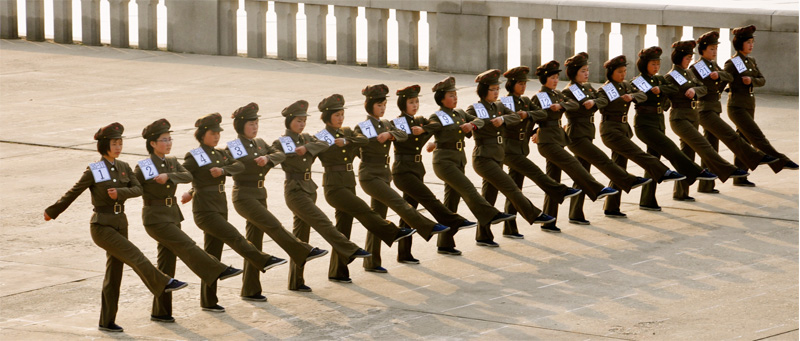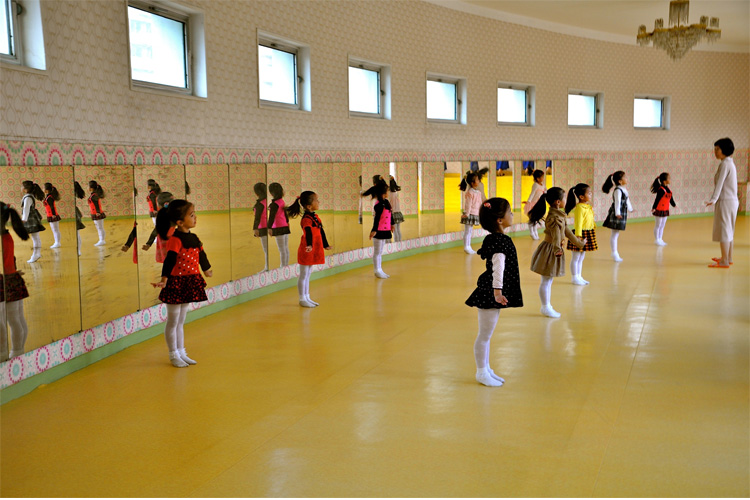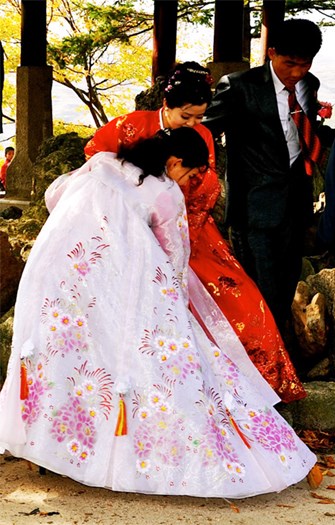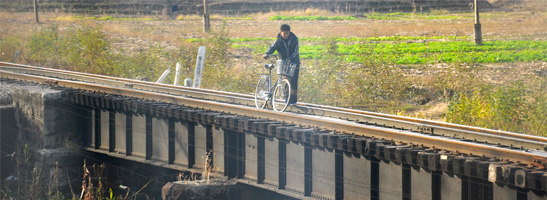PYONGYANG, NORTH KOREA – The woman yells “Qi Chuang! Qi Chuang!” in Mandarin as she slams our cabin door and orders us to get out of bed and fetch our travel documents for inspection halfway through our 27-hour train journey from Beijing to Pyongyang.
We’re stalled at the river’s edge of Dandong, a Chinese port city where North Korean defectors arrive after swimming across the frigid waters of the Yalu River, which separates the two Communist countries.
As the train chugs over the river, the skyscrapers lining Dandong’s shore diminish into white clusters in stark contrast to the grim, grey, pre-industrial dustbowl on the Korean side. Our first images of North Korea were labourers in tattered clothes shovelling coal briquettes and discoloured garden gnomes.
As we crossed over into Korea, our tour group frantically sends out our last text messages before our cell phones are taped up in envelopes, not to be opened until our departure.
A beaming portrait of North Korea’s founding father Kim Il-sung hangs atop the rail terminal. A plump young customs officer enters our cabin and rummages through our belongings, extracting a bag of makeup from a Belgian man’s luggage.
“Huh? Yours?” she asks in a shocked, shrill voice. Her faces blushes with embarrassment as she looks at the bag, then back at the tourist.
“Uh, yes, mine ... but gift, gift,” he says. (Our tour company had suggested that we bring gifts for our North Korean guides — perfume and cosmetics for the female guide and Marlboro cigarettes for the male guide).
The customs officer continues her inspection and discovers a vintage large format camera.
“Ah momomomomo, what’s this?” she inquires in awe, then leans in and watches with amusement as he shows her how to work the camera.
“Ooohhhhhh,” she says, motioning a colleague to watch. Next she picks up his tablet and glides her fingers across the screen, watching the icons flash by. “IPad?” she asks.
As she pokes through the rest of our bags, her middle-aged colleague browses through the latest issue of Monocle, a highbrow lifestyle magazine.
“Good,” he says smiling and giving a nod of approval before returning the magazine to its British owner. The Bible, the Qur’an, or any literature speaking out against the Democratic People’s Republic of Korea regime, is banned. (Journalists, too, but I gained access as a tourist).
After the inspection, our rickety train continues its journey to the capital, passing pastoral scenes where oxen pull carts across brown pastures while farmers work the land.

Above: The few westerners allowed into North Korea see a very disciplined society on the surface.
The beautiful, but dire countryside exposes the grittier side of the Hermit Kingdom we were expecting: gaunt citizens dressed in filthy Communist garb, toiling on dry brown fields as smiling portrayals of the Eternal President and Dear Leader watch over them. No one makes eye contact with us, but the few who dare have looks of either hopelessness or disdain for us.
“We are taught to hate Americans and some Europeans,” explains our guide as we ride the escalator in the Pyongyang subway.
Pak is a sweet young woman in her mid-20s whose favourite English book is ‘Gone with the Wind’ and favourite movie is Titanic. I thought these examples of American culture would be banned and unattainable, but she was able to find them in her university library, her studies giving her a portal to the outside world.
“When my classmates and I were learning English, we were embarrassed to look at each other when we practised,” she says.
“We would talk like this,” she whispers with her head down.
Pak was always smartly dressed in Mad Man-esque attire — a navy trench, tweed dress suit and high heels with her ink-black hair properly propped in a ponytail. She shuffles us around Pyongyang for four days, humanizing the country’s hard exterior with her soft sense of humour, an antidote to the militant aura of the repressive regime (personified by the shouting officers we meet at the Demilitarized Zone Concrete Wall).
Eager to learn, Pak jots down new English words and expressions. One New Yorker teaches her how to identify a hipster and adds street lingo like, “Get it together,” and “get on my level,” to her vocabulary.
On her off days, Pak tells us, she helps her mother, who is a doctor, with chores around the house. She’s single and says that the she dated once in university, which consisted of studying at the library — an innocent and anti-climactic tale of romance.
“When someone asks you: ‘When can I have your noodle?’ that is a marriage proposal,” she says, explaining North Korean marital customs, historically rooted in arranged marriages, but which have modernized to permit love matches.
“But parents’ opinion still matter,” she adds.


Above: During a closely guarded tour western journalists see kids dancing and a traditional wedding ceremony.
During a visit to a local brewery, we ask Pak where she would visit if she were allowed to freely travel.
“Germany,” she says, explaining that Germans were the first foreigners she met at a film festival in Pyongyang years ago.
Much of our visit is typical: distorted history lessons, Stalinist architecture and personality-cult propaganda. But there was some unexpected, dare I say it, fun. We play slots at a Macau-owned and operated casino, ride roller coasters at a fun fair and drink imported booze at a foreigners-only karaoke bar called “New Diplo.”
We also get a taste of everyday life riding the Pyongyang subway, learning about agriculture at a co-op farm, seeing newborns at a local maternity hospital and kindergarten kids going through their day.
But no matter how perfect everything was made to appear, cracks were easy to spot, like the empty streets, electricity shortages, decrepit buildings, inedible food, as well as underweight babies and robotic pre-schoolers all revealing the harsh realities of life in North Korea.
“Hunger is one of the main reasons why people defect,” says one of the men in the group who has worked with defectors. “North Koreans ate things we would never imagine eating — bark, mice, the family dog.”

Above: a scene of rural North Korea shot form a train shows life remains very primitive.
When it’s time to leave, Pak escorts us to the airport. Before we go through security, one of our group says Pak is welcome to stay with him if she ever gets the chance to visit Germany. Her eyes moisten as she nods and shakes his hand.
We say our goodbyes and make promises to stay in touch, but we know it’s probably the last time we’ll see her.
Information
- The most popular time to go to North Korea is during a national holiday or the Arirang Mass Games that run from August to October.
- Tourists cannot travel around the DPRK independently – they need to be chaperoned by two North Korean guides at all times. However, the most popular option is to sign up with a travel agency, most popular are: Koryo Tours, Young Pioneer Tours, just to name a few. There are direct flights from Beijing, and most recently Shanghai, to Pyongyang.
- North Korea is an expensive trip. Be sure to set aside $300 CAD per day for food, guides and accommodation.
- Euros or Chinese yuan are preferred. American dollars and Korean won are not accepted. It’s best to bring smaller notes.
- The DPRK is one of the safest places I’ve visited since you cannot go anywhere unchaperoned.